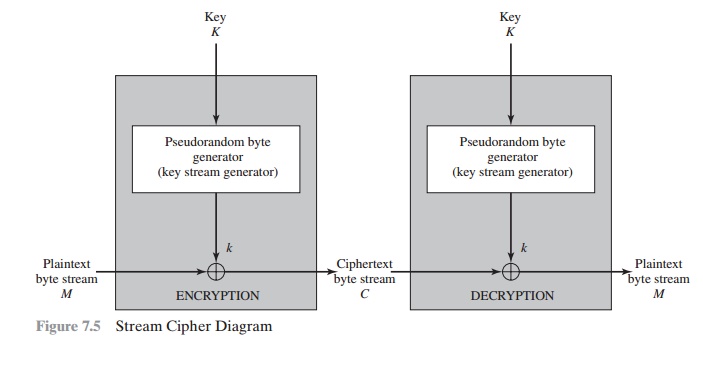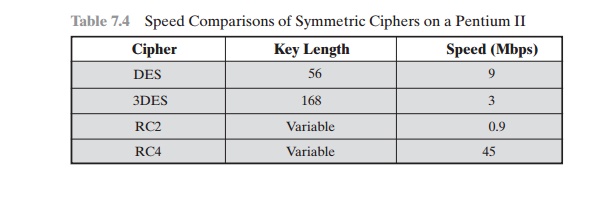Chapter: Cryptography and Network Security Principles and Practice : One Symmetric Ciphers : Pseudorandom Number Generation and Stream Ciphers
Stream Ciphers
STREAM
CIPHERS
A typical stream cipher encrypts plaintext one byte at a time, although a
stream cipher may be designed
to operate on one bit at a time or on units
larger than a byte
at a time. Figure 7.5 is a representative diagram of stream cipher structure.
In this structure, a key is input to a pseudorandom bit generator that produces
a stream of 8-bit numbers that are
apparently random. The output of the generator, called a keystream, is combined
one byte at a time with the plaintext stream using the bit- wise exclusive-OR (XOR) operation. For example,
if the next byte generated
by the generator is 01101100
and the next plaintext byte is 11001100, then the resulting ciphertext byte is


Decryption requires the use of the same pseudorandom sequence:

The stream cipher is similar to the one-time pad
discussed in Chapter 2. The difference is that a one-time pad uses a genuine random number stream,
whereas a stream cipher
uses a pseudorandom number stream.
[KUMA97]
lists the following important design considerations for a stream cipher.
1.
The encryption
sequence should have a large period. A pseudorandom num- ber generator uses a function
that produces a deterministic stream
of bits that eventually repeats. The longer the period of repeat the more difficult
it will be to do cryptanalysis. This
is essentially the same
consideration that was discussed
with reference to the Vigenère cipher, namely that the longer the keyword the more difficult the cryptanalysis.
2.
The keystream
should approximate the properties of a true random number stream
as close as possible. For example, there should be an approximately equal
number of 1s and 0s. If the keystream
is treated as a stream of bytes, then all of the 256 possible byte values should
appear approximately equally often. The more
random-appearing the keystream
is, the more randomized the ciphertext is, making
cryptanalysis more difficult.
3.
Note from Figure 7.5 that the output of
the pseudorandom number generator is conditioned
on the value of the input key. To guard against brute-force attacks, the key needs to be
sufficiently long. The same considerations that apply to block ciphers are
valid here. Thus, with current technology, a key length
of at least 128 bits is desirable.

With
a properly designed pseudorandom number generator, a stream cipher can be as secure
as a block cipher of comparable key length. A potential advantage of a stream cipher is that stream ciphers
that do not use block ciphers as a building block are typically faster
and use far less code than do block ciphers.
The example in this chapter,
RC4, can be implemented in just a few lines
of code. Table 7.4, using
data from [RESC01], compares execution
times of RC4 with three symmetric block ciphers. One advantage of a block
cipher is that you can reuse keys. In
contrast, if two plaintexts are encrypted with the same key using a stream
cipher, then crypt- analysis is often quite simple [DAWS96].
If the two ciphertext streams
are XORed together, the result
is the XOR of the original plaintexts. If the plaintexts are text strings, credit card numbers, or other byte streams with known properties, then cryptanalysis may be successful.
For applications that require
encryption/decryption of a stream of data, such as over a data communications
channel or a browser/Web link, a
stream cipher might be the better alternative. For applications that deal with blocks of data, such as file transfer, e-mail, and database, block ciphers may be more appropriate. However, either type of
cipher can be used in virtually any application.
A stream cipher can be constructed with any
cryptographically strong PRNG, such as the ones discussed in Sections 7.2 and 7.3.
In the next section, we look at a stream cipher that uses a PRNG designed
specifically for the stream cipher.
Related Topics